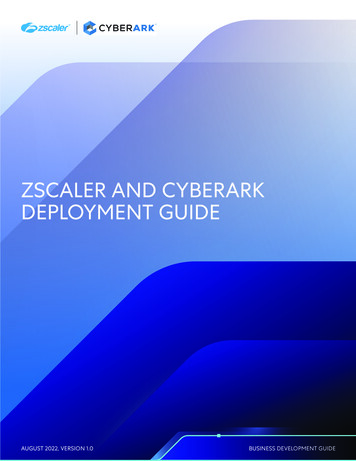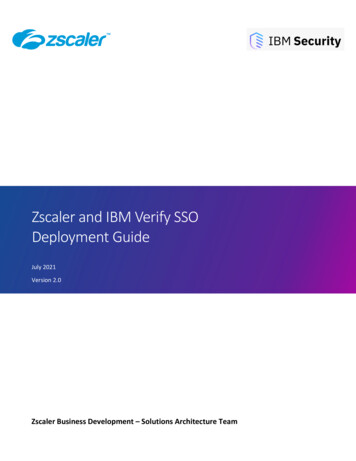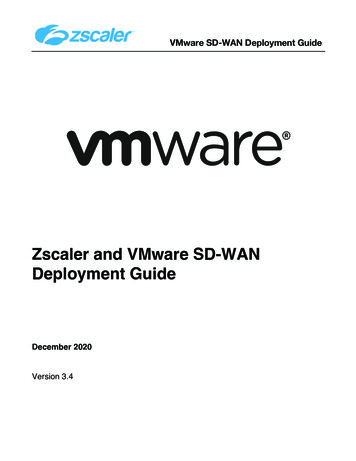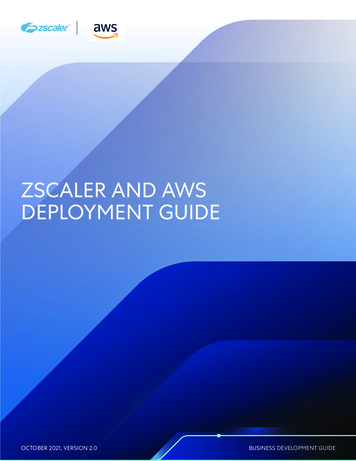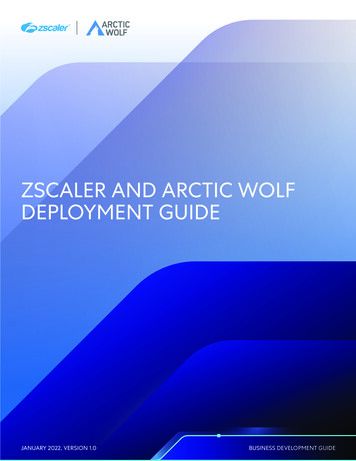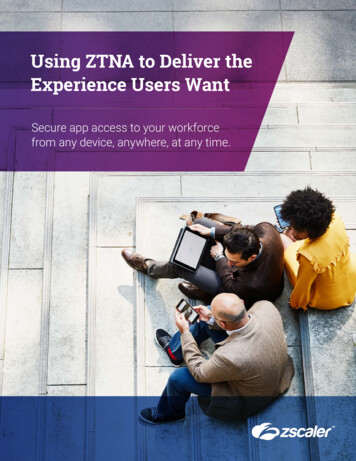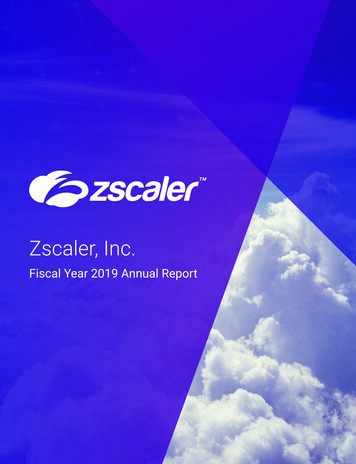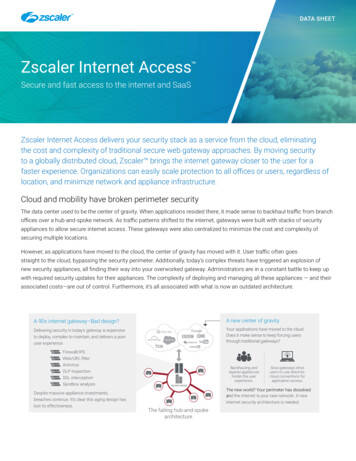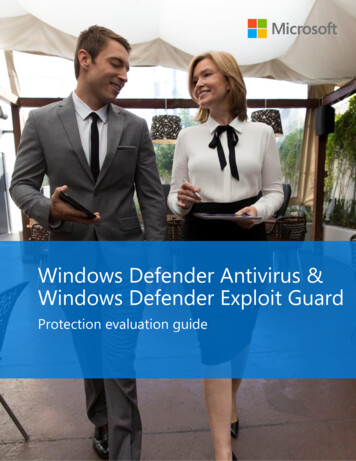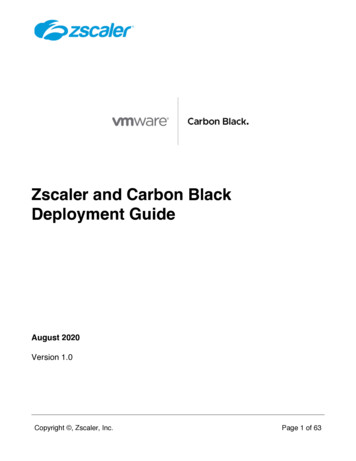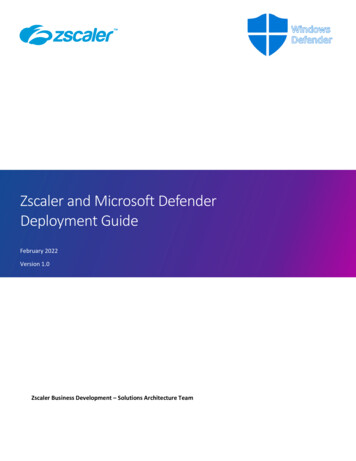
Transcription
Zscaler and Microsoft DefenderDeployment GuideFebruary 2022Version 1.0Zscaler and Microsoft DefenderDeployment GuideZscaler Business Development – Solutions Architecture Team
Zscaler and Microsoft Defender Deployment GuideTable of ContentsTerms and Acronyms . 3About This Document . 4Zscaler Overview. 4Microsoft Overview . 4Audience . 4Software Versions . 4Request for Comments . 4Zscaler and Microsoft Introduction . 5Zscaler Overview. 5Zscaler Internet Access (ZIA) Overview .5Zscaler Private Access (ZPA) Overview.5Zscaler Resources .5Defender Overview . 6Defender Resources .6ZIA and Microsoft Defender . 7Prerequisites . 7Integrating with Microsoft Defender for Endpoint . 8ZIA Hits Report .11Viewing the Microsoft Defender Endpoint Hits Report . 11About the Microsoft Defender Endpoint Hits Report . 12Sandbox File Properties (Zscaler) . 12File Detected on Endpoints (Microsoft Defender for Endpoint) . 13ZPA Posture Type.16Configuring Zscaler Private Access (ZPA). 17Log into ZPA Admin Portal . 17Navigate to the Zscaler Client Connector . 17Create a New Posture Profile . 18Add New Microsoft Defender Posture Profile . 18Decide Which Applications Need Conditional Access . 19Set Up an Access Policy . 20Tie the Posture Profile to this Access Policy . 20Copyright 2022, Zscaler, Inc.Page 1
Zscaler and Microsoft Defender Deployment GuideVerify Conditional Access from an Endpoint. 22Appendix A: Requesting Zscaler Support .24Gather Support Information . 24Save Company ID. 24Enter Support Section . 25Copyright 2022, Zscaler, Inc.Page 2
Zscaler and Microsoft Defender Deployment GuideTerms and ENZPACopyright 2022, Zscaler, Inc.DefinitionCentral Authority (Zscaler)Comma-Separated ValuesDead Peer Detection (RFC 3706)Generic Routing Encapsulation (RFC2890)Internet Key Exchange (RFC2409)Internet Protocol Security (RFC2411)Perfect Forward SecrecyPre-Share KeySecure Socket Layer (RFC6101)X-Forwarded-For (RFC7239)Zscaler Internet Access (Zscaler)Zscaler Enforcement Node (Zscaler)Zscaler Private Access (Zscaler)Page 3
Zscaler and Microsoft Defender Deployment GuideAbout This DocumentZscaler OverviewZscaler (Nasdaq: ZS), enables the world’s leading organizations to securely transform their networks andapplications for a mobile and cloud-first world. Its flagship Zscaler Internet Access (ZIA) and Zscaler PrivateAccess (ZPA) services create fast, secure connections between users and applications, regardless of device,location, or network. Zscaler delivers its services 100% in the cloud and offers the simplicity, enhanced security,and improved user experience that traditional appliances or hybrid solutions can’t match. Used in more than185 countries, Zscaler operates a massive, global cloud security platform that protects thousands of enterprisesand government agencies from cyberattacks and data loss. For more information on Zscaler, visitwww.zscaler.com or follow Zscaler on Twitter @zscaler.Microsoft OverviewMicrosoft ( MSFT), Microsoft develops and licenses consumer and enterprise software. It is known for itsWindows operating systems and Office productivity suite. The company is organized into three equally sizedbroad segments: productivity and business processes (legacy Microsoft Office, cloud-based Office 365,Exchange, SharePoint, Skype, LinkedIn, Dynamics), intelligence cloud (infrastructure- and platform-as-a-serviceofferings Azure, Windows Server OS, SQL Server), and more personal computing (Windows Client, Xbox, Bingsearch, display advertising, and Surface laptops, tablets, and desktops).AudienceThis guide is for network administrators, endpoint and IT administrators, and security analysts responsible fordeploying, monitoring, and managing enterprise security systems. For additional product and companyresources, refer to: Zscaler ResourcesDefender ResourcesAppendix A: Requesting Zscaler SupportSoftware VersionsThis document was authored using Zscaler Internet Access and Zscaler Private Access (with Zscaler ClientConnector) along with Microsoft Defender on Windows 10.Request for Comments For Prospects and Customers: We value reader opinions and experiences. Please contact us at partnerdoc-support@zscaler.com to offer feedback or corrections for this guide.For Zscaler Employees: Contact z-bd-sa@zscaler.com to reach the team that validated and authored theintegrations in this document.Copyright 2022, Zscaler, Inc.Page 4
Zscaler and Microsoft Defender Deployment GuideZscaler and Microsoft IntroductionZscaler OverviewOverviews of the Zscaler and Microsoft applications are described in this section.Zscaler Internet Access (ZIA) OverviewZscaler Internet Access (ZIA) is a secure Internet and web gateway delivered as a service from the cloud. Think ofZIA as a secure Internet onramp—just make Zscaler your next hop to the Internet via one of the followingmethods: Setting up a tunnel (GRE or IPSec) to the closest Zscaler data center (for offices).Forwarding traffic via our lightweight Zscaler Client Connector or PAC file (for mobile employees).No matter where users connect—a coffee shop in Milan, a hotel in Hong Kong, or a VDI instance in SouthKorea—they get identical protection. ZIA sits between your users and the Internet and inspects everytransaction inline across multiple security techniques (even within SSL).You get full protection from web and Internet threats. The Zscaler cloud platform supports cloud Firewall, IPS,sandboxing, data loss prevention (DLP), cloud access security broker (CASB), and browser isolation, allowing youstart with the services you need now and activate others as your needs grow.Zscaler Private Access (ZPA) OverviewZscaler Private Access (ZPA) is a cloud service that provides secure remote access to internal applicationsrunning on cloud or data center using a zero trust framework. With ZPA, applications are never exposed to theinternet, making them completely invisible to unauthorized users. The service enables the applications toconnect to users via inside-out connectivity rather than extending the network to them.ZPA provides a simple, secure, and effective way to access internal applications. Access is based on policiescreated by the IT administrator within the ZPA Admin Portal and hosted within the Zscaler cloud. On each userdevice, a piece of software called Zscaler Client Connector is installed. Zscaler Client Connector ensures theuser’s device posture and extends a secure micro-tunnel out to the Zscaler cloud when a user attempts to accessan internal application.Zscaler ResourcesThe following table contains links to Zscaler resources based on general topic areas.NameDefinitionZIA Help PortalHelp articles for ZIA.ZPA Help PortalHelp articles for ZPAZscaler ToolsTroubleshooting, security and analytics, and browser extensions that helpZscaler determine your security needs.Zscaler Training andCertificationTraining designed to help you maximize Zscaler products.Submit a Zscaler SupportTicketZscaler support portal for submitting requests and issues.Copyright 2022, Zscaler, Inc.Page 5
Zscaler and Microsoft Defender Deployment GuideDefender OverviewMicrosoft 365 Defender, part of Microsoft’s XDR solution, leverages the Microsoft 365 security portfolio toautomatically analyze threat data across domains, building a complete picture of each attack in a singledashboard. Microsoft 365 Defender detects and stops attacks anywhere in the kill chain and returns theorganization to a secure state.Microsoft Defender is a next-generation component that brings together machine learning, big-data analysis, indepth threat resistance research, and the Microsoft cloud infrastructure to protect devices (or endpoints) inyour organization. Microsoft Defender Antivirus is built into Windows, and it works with Microsoft Defender forEndpoint to provide protection on your device and in the cloud.Defender ResourcesThe following table contains links to Microsoft Defender support resources.NameMicrosoft DefenderdocumentationMicrosoft Defender supportRestrict app executionAutomated investigationStop and quarantine filesBlock or allow a fileCopyright 2022, Zscaler, Inc.DefinitionOnline help articles for Microsoft Defender.Support contact for Microsoft DefenderHelp article on locking down a device and preventing subsequentattempts of potentially malicious programs from running.Help article on starting a new general purpose automated investigationon the device if needed.Help article on containing an attack in your organization by stopping themalicious process and quarantining the file.Help article on banning potentially malicious files or suspectedmalware.Page 6
Zscaler and Microsoft Defender Deployment GuideZIA and Microsoft DefenderZscaler's integration leverages Microsoft Defender for Endpoint APIs to provide endpoint detection andresponse (EDR) visibility for Sandbox-detected malware. Once configured, the Zscaler service calls the MicrosoftDefender for Endpoint API and requests information for endpoints that were exposed to the malicious file.Microsoft Defender for Endpoint uses the new file signature to detect compromised points throughout yourorganization's network.Figure 1. ZIA and Microsoft Defender overviewYou can view information about the affected endpoints in the Sandbox logs and reports of the ZIA Admin Portal.You can also isolate endpoints, start automated investigation and remediation (AIR), and stop malicious fileexecutions from the ZIA Admin Portal. For further investigation and remediation, you can go to the MicrosoftDefender for Endpoint portal . These automated workflows reduce the threat dwell time and remediation time.PrerequisitesBefore you begin the Microsoft Defender for Endpoint integration, ensure you have: A Microsoft Defender for Endpoint admin accountAdvanced Cloud SandboxTo learn more, see the Microsoft Defender for Endpoint documentation.Copyright 2022, Zscaler, Inc.Page 7
Zscaler and Microsoft Defender Deployment GuideIntegrating with Microsoft Defender for EndpointTo integrate the Zscaler service with Microsoft Defender for Endpoint:Go to Administration Partner Integrations.Figure 2. Zscaler Partner IntegrationsClick the Microsoft Defender for Endpoint tab.Figure 3. Microsoft Defender for EndpointsCopyright 2022, Zscaler, Inc.Page 8
Zscaler and Microsoft Defender Deployment GuideUnder Authorize Microsoft Defender for Endpoint, click Provide Admin Credentials.Figure 4. Authorize Microsoft DefenderThe Microsoft Defender for Endpoint portal appears. Log in to Microsoft Defender for Endpoint.Figure 5. Login to Microsoft DefenderCopyright 2022, Zscaler, Inc.Page 9
Zscaler and Microsoft Defender Deployment GuideReview the required permissions for the Zscaler service to access Microsoft Defender for Endpoint andclick Accept.Figure 6. Accept Microsoft Defender permissionsAfter the authorization is complete, the Zscaler SaaS Connector and Directory (Tenant) ID appear.Figure 7. Authorization CompleteClick Save.If your Microsoft Defender for Endpoint credentials are valid, the Zscaler service calls the Microsoft Defender forEndpoint APIs and syncs your endpoint hits to the Zscaler service. You then can view file and endpointinformation in the Microsoft Defender Endpoint Hits report.Copyright 2022, Zscaler, Inc.Page 10
Zscaler and Microsoft Defender Deployment GuideZIA Hits ReportIf you integrated with Microsoft Defender for Endpoint, you can view information on endpoints that have beenexposed to a potentially malicious file. After the Sandbox analyzes a file, you can click the MD5 hash andchoose View Microsoft Defender Endpoint Hits. The Microsoft Defender Endpoint Hits report provides visibilityinto all the endpoints installed and detected with Microsoft Defender for Endpoint. The Microsoft Defender forEndpoint integration leverages the Microsoft advanced threat hunting, incidentresponse, and EDR capabilities and allows you to quarantine endpoints detected with the indicator ofcompromise (IOC). This IOC enrichment is important for: Tracing patient 0 events if the Zscaler service is configured to allow unknown files while sandboxing.Threat hunting to prevent attackers from spreading malware and moving laterally across your network.Incident responses from an infection caused by lateral movement or an out-of-band channel (e.g., USB).After the integration is configured, admins can go to the Microsoft Defender for Endpoint portal to get morecontextual information about the detection of the IOC or indicator of attack (IOA) before deciding to quarantinethe endpoint or take remedial action.Viewing the Microsoft Defender Endpoint Hits ReportTo view the Microsoft Defender Endpoint Hits report, click the MD5 hash for any file analyzed by Sandbox andchoose View Microsoft Defender Endpoint Hits.Figure 8. Insights LogsCopyright 2022, Zscaler, Inc.Page 11
Zscaler and Microsoft Defender Deployment GuideAbout the Microsoft Defender Endpoint Hits ReportIn the Microsoft Defender Endpoint Hits report, you can view file and endpoint information from theZscaler service and Microsoft Defender for Endpoint.Sandbox File Properties (Zscaler)In this section, you can view general information about the file from the Zscaler Sandbox analysis. The followinginformation appears:Figure 9. Microsoft Defender endpoint hits Sandbox File Properties Sandbox Category: The type of file. The following categories appear:ooo Sandbox Adware: Files that automatically render advertisements and install adware.Sandbox Malware/Botnet: Files that behave like APTs, exploits, botnets, trojans, keyloggers,spyware, and other malware.Sandbox P2P/Anonymizer: Files that contain anonymizers and P2P clients.Sandbox Score: The threat score determined from the Sandbox analysis.Threat Name: The threat name of the file. Click to go to the Zscaler Threat Library to learn more aboutthe file.File Type: The type of file (e.g., Windows Executable).File Size: The total bytes of the file.MD5: The MD5 hash of the file. Click to view the Sandbox Detail Report.SHA-1: The SHA-1 hash of the file. You can use it to find identical files.SHA-256: The SHA-256 hash of the file. You can use it to find identical files.SSDEEP: The ssdeep hash of the file. You can use it to find partial matches with other suspicious files.Copyright 2022, Zscaler, Inc.Page 12
Zscaler and Microsoft Defender Deployment GuideFile Detected on Endpoints (Microsoft Defender for Endpoint)A list of endpoints on which the file was detected via Microsoft Defender for Endpoint.Figure 10. File detected on Microsoft Defender endpoint Microsoft Defender Agent ID: The ID of Microsoft Defender agent installed on the host.Hostname: The name of the host.Internal IP: The internal IP address of the host.External IP: The external IP address of the host.OS Version: The operating system and version of the host.First Seen: The first time the file was detected on the endpoint.Last Seen: The last time the file was detected on the endpoint. You can sort this column.File Status: The status of the file.oooo Endpoint Status: The status of the endpoint. The following states appear:oo Seen: The Microsoft Defender agent saw the file on the host.Detected: The Microsoft Defender agent triggered a detection based on a process or anoperation associated with the file.Quarantined: The Microsoft Defender agent stopped the ongoing processes of the file andremoved it from the host.Remediated: The Microsoft Defender agent used automated investigation and remediation(AIR) capabilities to remediate the file.Active: The endpoint is not quarantined.Isolated: The endpoint is quarantined.Actions: Call the Microsoft Defender for Endpoint API to perform one of the following actions.oIsolate: Click to quarantine the endpoint. This option only appears if the endpoint statusis Active.Copyright 2022, Zscaler, Inc.Page 13
Zscaler and Microsoft Defender Deployment GuideFigure 11. Isolate HostoStop Current Executions: Click to stop any ongoing processes associated with the file on theendpoint.Figure 12. Kill ongoing execution and quarantine fileoTrigger Alert & Start AIR: Click to trigger an alert and start AIR on the endpoint. To learn moreabout configuring AIR, see the Microsoft Defender for Endpoint documentation.Copyright 2022, Zscaler, Inc.Page 14
Zscaler and Microsoft Defender Deployment GuideFigure 13. Generate alert and trigger Prevent Future Executions: Click to stop any future processes of the file on all endpoints.Figure 14. Prevent future executionsCopyright 2022, Zscaler, Inc.Page 15
Zscaler and Microsoft Defender Deployment GuideZPA Posture TypeIn this use case: Zscaler Private Access (ZPA) verifies the presence of a running Microsoft Defender process on theendpoint as an assessment of end device posture. ZPA can be configured to allow only compliantendpoints (ones that pass the posture check) to access selected applications.ZPA evaluates ZPA “Access Policies” for conditional access. The policies, in turn, reference device level“posture check profiles.” The ZPA administrator can specify (for Windows and Mac workstations) that aMicrosoft Defender agent must be installed and running on the endpoint so that the endpoint can begranted access to internal applications referenced via ZPA Access policy.See the following conceptual diagram for an overview of the integration.Figure 15. ZPA and Microsoft Defender overviewCopyright 2022, Zscaler, Inc.Page 16
Zscaler and Microsoft Defender Deployment GuideConfiguring Zscaler Private Access (ZPA)This guide assumes that you have a working ZPA setup and provides instructions to integrate posture-basedconditional access as part of your existing ZPA deployment.Log into ZPA Admin PortalFigure 16. Log into ZPA Admin PortalNavigate to the Zscaler Client ConnectorClick the Zscaler Client Connector icon to open the Zscaler Client Connector.Figure 17. Click the Zscaler Client Connector iconCopyright 2022, Zscaler, Inc.Page 17
Zscaler and Microsoft Defender Deployment GuideCreate a New Posture ProfileLog into the Zscaler Client Connector and navigate to Administration Device Posture. Then click Add DevicePosture ProfileFigure 18. Add a device posture profileAdd New Microsoft Defender Posture ProfileComplete the following steps:Select only Windows, macOS, or both.Click the Posture Type dropdown menu.Select Detect Microsoft Defender.Name this policy and click Save.This posture profile is referenced in a ZPA Access Policy. Access policies can be setup to allow or denyapplication access based on whether the posture check passes or fails.Figure 19. Add a detect Microsoft Defender posture profileCopyright 2022, Zscaler, Inc.Page 18
Zscaler and Microsoft Defender Deployment GuideDecide Which Applications Need Conditional AccessWithin the ZPA Admin Portal, navigate to Administration Application SegmentThis page lists which applications can be accessed by ZPA. Select one of these applications and reference it in anaccess policy so that access to it is granted based on the end device’s posture.Figure 20. Navigate to application segmentsIn this example, ZPA can access applications hosted under the domain *.bd-dev.com, based on posture of theend device.Figure 21. Decide which application needs conditional accessCopyright 2022, Zscaler, Inc.Page 19
Zscaler and Microsoft Defender Deployment GuideSet Up an Access PolicyWithin the ZPA Admin Portal, navigate to Administration Access Policy.Figure 22. Open access policy configuration dialogTie the Posture Profile to this Access PolicyCreate a new access policy by clicking on Add Rule and reference the previously created posture profile.Customers can setup different access policies to protect different internal applications.A customizable (and optional) popup message can be shown to the end users when application access is allowedor denied, informing them about the policy evaluation.In this example, we added an access policy to block user access to the application if the Microsoft Defenderposture check fails (Rule#1). If Microsoft Defender is not running on the endpoint, Rule#1 is marked true andaccess is blocked. Otherwise, the policy evaluation proceeds to Rule#2 (which will grant application access).Copyright 2022, Zscaler, Inc.Page 20
Zscaler and Microsoft Defender Deployment GuideFigure 23. Setup an access policyCopyright 2022, Zscaler, Inc.Page 21
Zscaler and Microsoft Defender Deployment GuideVerify Conditional Access from an EndpointThe endpoint should be able to access the application if the endpoint device has a Microsoft Defender agentinstalled and running. Otherwise, the access is blocked by ZPA.Figure 24. Access granted from an endpoint with the Microsoft Defender agent installed and runningCopyright 2022, Zscaler, Inc.Page 22
Zscaler and Microsoft Defender Deployment GuideFigure 25. Access blocked from an endpoint if the Microsoft Defender agent is not runningCopyright 2022, Zscaler, Inc.Page 23
Zscaler and Microsoft Defender Deployment GuideAppendix A: Requesting Zscaler SupportYou might need Zscaler support for provisioning certain services, or to help troubleshoot configuration andservice issues. Zscaler support is available 24/7 hours a day, year-round.Gather Support InformationTo contact Zscaler support, select Administration Settings and then click Company profile.Figure 26. Collecting details to open support case with Zscaler TACSave Company IDCopy your Company ID.Figure 27. Company IDCopyright 2022, Zscaler, Inc.Page 24
Zscaler and Microsoft Defender Deployment GuideEnter Support SectionWith your company ID information, you can open a support ticket. Navigate to Dashboard Support Submit aTicket.Figure 28. Submit a ticketCopyright 2022, Zscaler, Inc.Page 25
Zscaler Internet Access (ZIA) is a secure Internet and web gateway delivered as a service from the cloud. Think of ZIA as a secure Internet onramp—just make Zscaler your next hop to the Internet via one of the following methods: Setting up a tunnel (GRE or IPSec) to the closest Zscaler data center (for offices).
